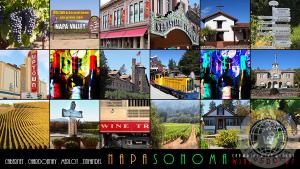Napa Sonoma County California Wine Country By Wingsdomain Art And Photography

April 25th, 2015 - SF Bay Area, CA
Pick Here to Purchase Print, watermark will not show on print
or Pick HERE for more Napa Sonoma California Wine Country Art and Photography
< Back to Feature Gallery
The Wine Country is an area of Northern California in the United States known world-wide as a premium wine-growing region. Viticulture and wine-making have been practiced in the region since the mid-19th century. There are over 400 wineries in the area north of San Francisco, mostly located in the area's valleys, including Napa Valley in Napa County, and the Sonoma Valley, Alexander Valley, Dry Creek Valley, Bennett Valley, and Russian River Valley in Sonoma County. Wine grapes are also grown at higher elevations, such as Atlas Peak and Mount Veeder AVAs. The region is defined not only in terms of viticulture, but also its ecology, geology, architecture, cuisine, and culture. The majority of the grape harvest, in terms of both area and value, derives from Sonoma County.
Cities and towns associated with the Wine Country include Santa Rosa, Healdsburg, Sonoma, Kenwood, Petaluma, Sebastopol, Guerneville, Windsor, Geyserville, and Cloverdale in Sonoma County; Napa, Yountville, Rutherford, St. Helena and Calistoga in Napa County; and Hopland and Ukiah in Mendocino County.
Napa Wine Country
Napa Valley is widely considered one of the top American Viticultural Areas in California, and all of the United States, with a history dating back to the early nineteenth century. By the end of the nineteenth century, there were more than 140 wineries in the area. Of those original wineries several still exist in the valley today including Charles Krug Winery, Schramsberg, Chateau Montelena, Nichelini and Beringer. Viticulture in Napa suffered a setback when prohibition was enacted across the country in 1920. Furthering the damage was an infestation of the phylloxera root louse which killed many of the vines through the valley. These two events caused many wineries to shut down and stalled the growth of the wine industry in Napa County for years. But for many Italian and Swiss families as farm labor in the vineyards, Prohibition offered the unique opportunity for the growing and shipping of grapes to immigrant homewinemakers across the country. Charles Forni, who received a gold coin as his first U.S. dollar upon arriving, rose to be a large shipper. The Mondavi family came West from the Minnesota ore-country to Lodi to ship grapes to the "Italian Club" miners. When Prohibition stopped in 1933, the price of grapes crashed to below $24 per ton. Then A.P. Giannini, founder of Bank of America at San Francisco, started to promote to rebuild the commerce of wine and viticulture. Following the Second World War, the wine industry in Napa again began to grow. But cattle and prunes were king.
In 1965, Napa Valley icon Robert Mondavi broke away from his family's Charles Krug estate to found his own. This was the first new large scale winery to be established in the valley since before prohibition. Following the establishment of the Mondavi estate, the number of wineries in the valley continued to grow, as did the region's reputation. Consumer trends followed the 60s free lifestyle for experimentation. The old "paesano" customers of "dego red" gallon jug wines changed to young women who considered white wine, not beer, as their new drink of choice for romance. Robert Mondavi Winery attracted new wine aficionados by introducing the larger, 1.5 wine bottle for an image of affordable quality.
In addition to large scale wineries, Napa Valley's boutique wineries produce some of the world's best wines. The producers of these wines include but are not limited to: Araujo, Bryant Family, Chimney Rock Winery, Colgin Cellars, Dalla Valle Maya, Diamond Creek, Dominus Estate, Duckhorn Vineyards, Dunn Howell Mountain, Grace Family Vineyards, Harlan Estate, Husic, Kistler, Jericho Canyon Vineyards, Marcassin, Rutherford Hill Winery, Screaming Eagle, Sequoia Grove, Shafer Hillside Select, Spencer-Roloson Winery, Steltzner Vineyards and Bouchaine Vineyards.
Today Napa Valley features more than four hundred wineries and grows many different grape varieties including Cabernet Sauvignon, Chardonnay, Merlot, Zinfandel, and other popular varietals. Napa Valley is visited by as many as five million people each year.
Sonoma Wine Country
Winemakingóboth the growing of the grapes and their vintingóis an important part of the economic and cultural life of Sonoma County. In 2004, growers harvested 165,783 tons (150,396 tonnes) of wine grapes worth US$310 million. In 2006 the Sonoma County grape harvest amounted to over 185,000 tons, exceeding Napa County's harvest by over 30 percent. About 80 percent of non-pasture agricultural land in the county is for growing wine grapesó59,973 acres (242.70 km≤) of vineyards, with over 1100 growers. The most common varieties planted are Chardonnay, Cabernet Sauvignon, and Pinot noir, though the area is also known for its Merlot and Zinfandel.
Sonoma County is home to more than 250 wineries with eleven distinct and two shared American Viticultural Areas, including the Sonoma Valley AVA, Russian River Valley AVA, Alexander Valley AVA, Bennett Valley AVA and Dry Creek Valley AVA, the last of which is known for the production of high-quality Zinfandels.
- All descriptions courtesy of Wikipedia.
Wingsdomain.com creates and sells quality unique fine art and photography prints and is open to everybody including Designers, Decorators, Hotel Operators, Restaurant Owners, Retail Stores, Art Galleries, and all other trades, as well as for the weekend decorator wanting to enhance any space in their home. Volume discounts available. Licensing available for most art and photography. Email wingsdomain@hotmail.com for more details.
Join my Mailing List !
For $4.3 million you can get a Gursky. For $43 million you can get a Lichtenstein. And for just a tad under $120 million, you can get a Munch. Luckily for everyone else, there is Wingsdomain Art and Photography!
The Studio X Project

